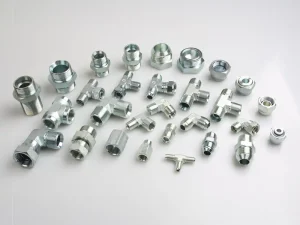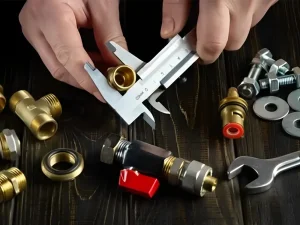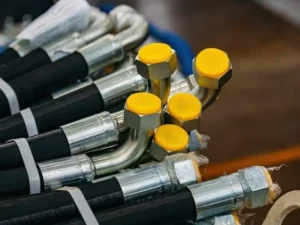A crucial part of a hyd system is the hydraulic fittings. For example, tubes, valves, and pumps are often linked to each other by this component. A hydraulic fitting is usually made to handle a lot of pressure. It plays a critical role in a hydraulic system. So, a good installation is needed to ensure the optimal performance.
To do a hydraulic fitting correctly, you need to know enough about how to do it. For this task, it is essential to pick the right product. So, read this article very carefully. We hope it helps you get a real job.
What is hydraulic fitting?

A hydraulic fitting is a hydraulic system component. It connects hoses, pumps, and valves. Its primary job is to enable the transmission of hydraulic fluid or oil within the system. These fittings facilitate the transfer of fluid under high pressure. It also controls the direction of flow. In general, it keeps hydraulic systems working well and in good shape.
There are different kinds of hydraulic fittings. Each type is made to work with various kinds of systems and setups. Based on metric standards, there are six distinct types. On the other hand, if you think of multiple shapes, you will find six more categories. In addition, based on different materials, the diversity continues. Read the “Types of Hydraulic Fittings” article to learn more about its diversity.
It is vital to choose the proper hydraulic fitting. That’s what hydraulic systems need to work well and stay safe. It makes sure that the fluid motion works well. It also cuts down on downtime caused by leaks or other problems. Moreover, it makes hydraulic systems last longer and operate more reliably.
A hydraulic fitting works by connecting two hydraulic parts safely. When there is pressure on hydraulic fluids, it makes the motion easier. They have threaded or coupler connections that keep the cover tight. Furthermore, it stops leaks and keeps hydraulic systems in good shape.
How To Install Hydraulic Hose Fittings
It’s crucial to think carefully about how to install a hydraulic fitting. Every step is essential, from getting the tools ready to checking before the process. Remember that making one mistake can have bad results. If it’s used with high pressure, it can also be life-threatening. So, we always suggest following the instructions from the maker.
Step 1: Preparation (Tools & Materials)

Having the right tools to install hydraulic line fittings is crucial. Here’s a list of essentials:
- Adjustable Wrench
- Clamps & Hydraulic Hose Couplers
- Hydraulic Hose Cutter or Saw
- Adapters
- Teflon Tape
- Thread Sealant
- Clean Rags or Towels
- Hydraulic hose & Hydraulic Fitting
Easy access to tools and materials will ensure the work goes smoothly and quickly. It also reduces the risk of errors. Moreover, it provides a secure hydraulic connection. Note, don’t use any tools that may hamper the integrity of the hydraulic fitting. Do not use aggressive chemicals to clean or wipe dirt from the hydraulic hose or fitting.
Step 2: Select The Right Hydraulic Hose Fittings

Choosing the suitable hydraulic hose connector is essential for both safety and efficiency. Through this decision process, there are a few things you need to keep in mind.
Firstly, figure out what kind of hydraulic part you need. There are various types available. In the preceding section, we talked about it. Fittings come in different shapes and sizes: straight, elbow, tee, and cross. Each is suited for specific applications and configurations within the system.
Secondly, another essential factor is the pressure variety. The fittings must be strong enough to handle the hydraulic system’s highest pressure. You know, it stops failures or leaks.
Thirdly, the thread type of the hydraulic hose fitting must also be compatible with the corresponding components. It ensures proper seal and connection. Common thread types are NPT, BSPT, and metric threads.
Fourth, the coupler connection type tells you how the fittings join to other parts. You must choose parts with the correct connection types. It makes assembly and disassembly easier.
Fifth, the choice of material is essential for durability. Also, it must be resistant to rust and wear. Hydraulic hose fittings are usually made of steel, brass, or aluminum. Each offers different levels of durability. In addition, each offers additional compatibility with various fluids and environments.
Finally, the correct hydraulic fitting size determines the optimal performance. If the fittings are too big or small, they can stop the flow, lower the pressure, or cause leaks.
Step 3: Clean And Plan the Whole Installation
You must plan for the whole process when installing a hydraulic hose fitting. Most importantly, ensure proper cleanliness.
Cleanliness ensures a clean environment. It also prevents dust or debris from entering the system. You know, this dirt could affect the performance of the system. It may also create damage over time.
On the other hand, proper planning allows you to determine the optimal placement of the fitting. In this case, consider accessibility, routing, and main obstacles. You know, proper planning eliminates the risk of error. In addition, it mitigates rework. It saves not only time but also resources in the long run.
Step 4: Thread Sealing or Sing Teflon Tape
This process ensures that a connection between hydraulic hose parts is safe and doesn’t leak. Teflon tape is also known as plumber’s tape. It is commonly used for this purpose. The process begins by wrapping the male threading of the fitting. It is done with several layers of Teflon tape in a clockwise direction.
This tape helps to lubricate the threads. It creates a tighter seal when the fittings are joined. It also protects against leaks caused by gaps between the threads.
Step 5: Systematically Connect the Fittings
Ensure that the fitting fits perfectly with the connection point on the hydraulic system. Tighten the fitting by hand, bit by bit, until it’s securely in place.
After hand-tightening, use a tool or socket set to get even more tightening done. Do not use too much pressure, as overtightening could damage the joint and the system.
Step 6: Test And Check There Are Any Leaks
Once you are done with installing the hydraulic fitting, test it. It’s essential to test the system to make sure it works right.
Leaks can lead to loss of fluid. It also leads to reduced system efficiency. Ultimately, it results in potential hazards. Therefore, various methods are employed for leak detection. Leak detection methods include visual inspection, pressure testing, and leak detection dyes.
You can visually inspect connections and components for signs of fluid leakage. By pressure testing, you can monitor the pressure drop over time. Leak detection dues can be added to the hydraulic fluid. It fluoresces under UV light. It makes the leaks easily identifiable.
What makes Hyd Hose Fittings Fail?
For each hydraulic system to work well, it needs different parts. One of these parts is a hydraulic fitting. However, a few things could go wrong with this smooth process. The following reasons have the most impact on how the hydraulic fitting works. Also, they make things less safe and require expensive fixes.
Improper Installation
Incorrect assembly is the primary reason for hydraulic fitting failure. In addition, inadequate torque or using incompatible fittings can lead to leaks. Improper installation may also lead to loosening or improper sealing.
Contamination
The hydraulic fitting may fail due to contamination. The foreign particles or debris in the hydraulics can cause abrasive wear and blockages. It may also create damage to seals and valves. It finally leads to leaks and reduced system performance.
Impact Damage
It is one of the leading causes why your hydraulic fittings fail. Accidental impacts or collisions with heavy objects may rapture these fittings. It disrupts fluid flow and compromises system performance.
Vibration
Excessive vibrations can cause fittings to loosen over time. It leads to leaks, fatigue failure, or damage to the threads.
Over-pressure
Operating hydraulic systems above their rated pressure limits can cause fittings to deform, crack, or burst. It results in catastrophic failure, fluid leaks, and safety hazards.
Corrosion
Hydraulic valves can rust if they are exposed to water, chemicals, or conditions that are corrosive. It makes them less stable and leads to leaks or failure before its time.
Fatigue
Prolonged cyclic loading and stress on hydraulic fittings can lead to metal fatigue. It may manifest as cracks, fractures, or failure. It happens mainly in high-pressure applications.
Conclusion
Hydraulic fittings must be installed correctly. It makes sure that a hydraulic system works well and is safe. The proper steps must be taken, and the right parts must be chosen. Because of this, the chance of problems and mistakes is significantly reduced.
In addition, regular maintenance is necessary to detect early issues. You know, it also prevents costly repairs. It is crucial to emphasize the significance of proactive maintenance measures. Also, if you’re working on a complex installation, get help from a professional. It ensures the reliability of the system.
For more information and product inquiries, feel free to contact the Rentone Hose Customer supper team. Our dedicated personnel will be happy to assist.
